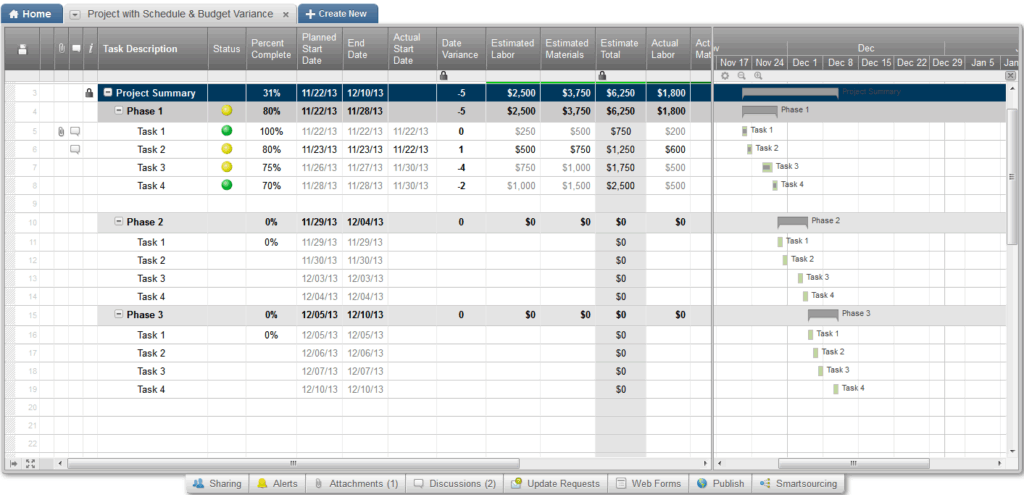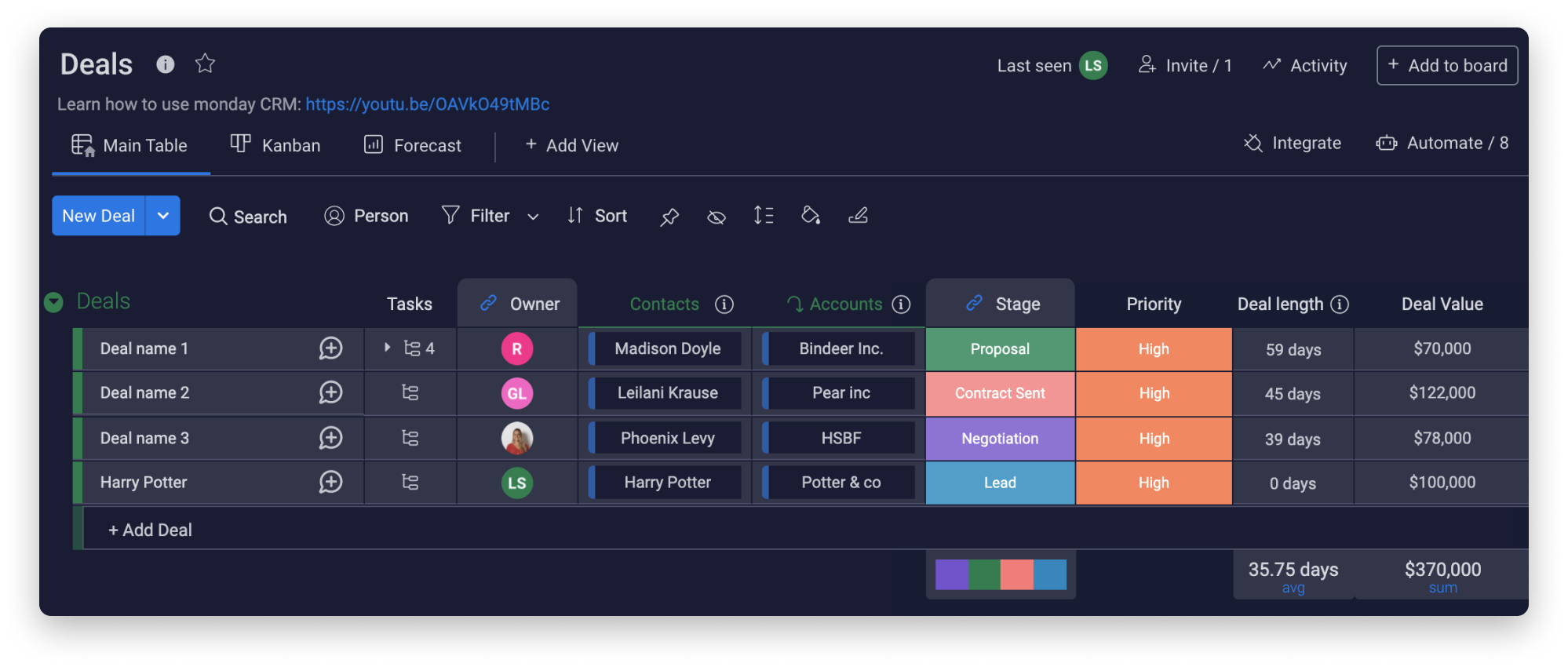
In today’s fast-paced business environment, efficiency and collaboration are key to success. Companies are constantly seeking ways to streamline their operations, improve communication, and make data-driven decisions. One powerful solution that addresses these needs is integrating a Customer Relationship Management (CRM) system with a work execution platform like Smartsheet. This article explores the benefits, implementation strategies, and best practices for CRM integration with Smartsheet, providing a comprehensive guide to help you optimize your workflows and achieve your business goals.
Understanding the Power of CRM and Smartsheet Integration
Before diving into the specifics, let’s establish a clear understanding of what CRM and Smartsheet are and why their integration is so beneficial.
What is CRM?
CRM, or Customer Relationship Management, is a technology that helps businesses manage and analyze customer interactions and data throughout the customer lifecycle. A good CRM system centralizes customer information, including contact details, purchase history, communication logs, and more. This allows businesses to:
- Improve customer service and support
- Personalize marketing campaigns
- Increase sales effectiveness
- Gain valuable insights into customer behavior
Popular CRM systems include Salesforce, HubSpot, Microsoft Dynamics 365, and Zoho CRM.
What is Smartsheet?
Smartsheet is a cloud-based work execution platform that enables teams to plan, track, automate, and report on work. It provides a flexible and intuitive interface that combines the familiar features of spreadsheets with project management capabilities. Smartsheet is used for a wide range of applications, including:
- Project management
- Marketing campaign tracking
- Sales pipeline management
- Operational workflows
Smartsheet’s versatility and collaborative features make it an ideal platform for streamlining processes and improving team communication.
Why Integrate CRM with Smartsheet?
Integrating your CRM system with Smartsheet unlocks a wealth of benefits, leading to improved efficiency, better decision-making, and increased revenue. Here are some key advantages:
- Enhanced Data Visibility: Seamlessly share customer data between your CRM and Smartsheet, providing a unified view of customer information across your organization.
- Automated Workflows: Automate tasks, such as creating Smartsheet projects when a new opportunity is won in your CRM, saving time and reducing manual errors.
- Improved Collaboration: Foster better collaboration between sales, marketing, and other teams by providing access to relevant data in a centralized location.
- Increased Productivity: Eliminate the need for manual data entry and reduce the time spent switching between applications, allowing your team to focus on more strategic tasks.
- Better Decision-Making: Gain real-time insights into your sales pipeline, marketing campaign performance, and customer interactions, enabling you to make data-driven decisions.
- Streamlined Sales Processes: Automate sales tasks, track deals, and manage customer interactions more effectively.
Key Benefits of CRM Integration with Smartsheet in Detail
Let’s delve deeper into some of the key benefits of integrating your CRM with Smartsheet, exploring how these integrations can transform your business operations.
1. Streamlined Sales Processes
CRM integration with Smartsheet can significantly streamline your sales processes. Imagine a scenario where a new lead is generated in your CRM. With integration, you can automatically trigger the creation of a new project in Smartsheet to manage the sales process for that lead. This could include tasks like sending follow-up emails, scheduling demos, and tracking the progress of the opportunity. This automation saves time, reduces manual errors, and ensures that no leads fall through the cracks. Sales teams can focus on closing deals rather than on administrative tasks.
2. Enhanced Marketing Campaign Management
Marketing teams can leverage the integration to better manage and track the performance of their campaigns. For instance, when a new marketing campaign is launched in your CRM, you can automatically create a Smartsheet project to track the campaign’s progress, budget, and key performance indicators (KPIs). You can then use Smartsheet to collaborate with team members, assign tasks, and monitor results. This integration ensures that marketing efforts are aligned with sales activities and helps you optimize your campaigns for maximum impact.
3. Improved Customer Service and Support
By integrating your CRM with Smartsheet, you can improve your customer service and support operations. When a customer submits a support ticket in your CRM, you can automatically create a Smartsheet project to manage the ticket resolution process. This might involve assigning the ticket to a support agent, tracking the progress of the issue, and sending updates to the customer. This ensures that customer issues are addressed promptly and efficiently, leading to higher customer satisfaction.
4. Better Data Visibility and Reporting
One of the most significant benefits of CRM integration with Smartsheet is the ability to gain better data visibility and reporting capabilities. By syncing data between the two systems, you can create comprehensive dashboards and reports that provide real-time insights into your business performance. For example, you can track sales pipeline progress, marketing campaign ROI, and customer satisfaction metrics in a single view. This data-driven approach allows you to make informed decisions and identify areas for improvement.
5. Increased Collaboration and Communication
Integration fosters better collaboration and communication across teams. Sales, marketing, customer service, and other departments can access the same data in a centralized location. This reduces the need for email chains and manual data transfers, which can often lead to errors and delays. Teams can work together more effectively, sharing information and coordinating their efforts to achieve common goals. This leads to improved productivity and a more cohesive work environment.
How to Integrate CRM with Smartsheet: Step-by-Step Guide
Integrating your CRM with Smartsheet can seem daunting, but with the right approach, it’s a manageable process. Here’s a step-by-step guide to help you get started:
1. Assess Your Needs and Define Your Goals
Before you begin the integration process, take the time to assess your needs and define your goals. What do you want to achieve by integrating your CRM with Smartsheet? Are you looking to automate sales processes, improve marketing campaign management, or enhance customer service? Clearly defining your goals will help you choose the right integration method and ensure that your integration meets your specific requirements.
2. Choose Your Integration Method
There are several ways to integrate your CRM with Smartsheet. The best method for you will depend on your specific needs and technical capabilities. Here are some common options:
- Native Integrations: Some CRM systems and Smartsheet offer native integrations, which are pre-built connectors that make it easy to sync data between the two systems. These integrations often require minimal setup and configuration.
- Third-Party Integration Platforms: Integration platforms like Zapier, Workato, and Automate.io allow you to connect your CRM with Smartsheet and other applications using a no-code or low-code approach. These platforms offer a wide range of pre-built connectors and automation workflows.
- API Integration: If you have more complex integration requirements, you can use the APIs (Application Programming Interfaces) of your CRM and Smartsheet to build custom integrations. This approach provides the most flexibility but requires technical expertise.
- Manual Data Import/Export: In some cases, you may opt for manual data import and export. This involves exporting data from your CRM and importing it into Smartsheet, or vice versa. While this method is the simplest, it’s not as efficient as automated integration.
3. Set Up Your Integration
Once you’ve chosen your integration method, it’s time to set up your integration. The specific steps will vary depending on the method you choose. Here are some general guidelines:
- Native Integrations: Follow the instructions provided by your CRM and Smartsheet to enable the native integration. This typically involves connecting your accounts and configuring the data sync settings.
- Third-Party Integration Platforms: Create an account with the integration platform and connect your CRM and Smartsheet accounts. Then, create automation workflows (also called “zaps”, “recipes”, or “automations”) to sync data between the two systems.
- API Integration: Work with your IT team or a developer to build a custom integration using the APIs of your CRM and Smartsheet. This will involve writing code to transfer data between the two systems.
- Manual Data Import/Export: Export data from your CRM in a format that can be imported into Smartsheet (e.g., CSV). Then, import the data into Smartsheet and map the fields accordingly.
4. Test Your Integration
Before you start using your integration in production, it’s essential to test it thoroughly. Create test records in your CRM and verify that they are syncing correctly with Smartsheet. Also, test any automation workflows to ensure that they are working as expected. This will help you identify and resolve any issues before they impact your business operations.
5. Train Your Team
Once your integration is set up and tested, train your team on how to use it. Provide them with documentation and training materials that explain how the integration works and how to use it effectively. This will help them to adopt the new system quickly and efficiently.
6. Monitor and Optimize Your Integration
After you’ve launched your integration, monitor its performance regularly. Check for any errors or data sync issues. If you encounter any problems, troubleshoot them and make adjustments as needed. You should also review your integration periodically to ensure that it’s meeting your evolving needs and that you’re getting the most out of it. Consider adding new features or improving existing automation workflows to further enhance your efficiency.
Best Practices for CRM Integration with Smartsheet
To maximize the benefits of your CRM integration with Smartsheet, follow these best practices:
1. Plan Your Data Mapping Carefully
Before you begin your integration, take the time to plan your data mapping carefully. Decide which fields from your CRM you want to sync with Smartsheet, and how you want to map them. This will ensure that data is transferred accurately and consistently between the two systems. Poor data mapping can lead to errors and inconsistencies, so it’s worth investing time in this step.
2. Automate Tasks Whenever Possible
One of the primary benefits of CRM integration with Smartsheet is the ability to automate tasks. Identify repetitive manual tasks that can be automated, such as creating Smartsheet projects when new opportunities are won in your CRM. Automating these tasks will save you time, reduce errors, and improve efficiency.
3. Keep Your Data Clean and Accurate
The success of your CRM integration depends on the quality of your data. Make sure that your data is clean and accurate in both your CRM and Smartsheet. Regularly review your data to identify and correct any errors or inconsistencies. This will ensure that your reports and dashboards are accurate and that you’re making informed decisions.
4. Use Custom Fields and Formulas
Leverage custom fields and formulas in Smartsheet to enhance your reporting and analysis capabilities. You can create custom fields to store data that is not available in your CRM, and you can use formulas to calculate metrics, such as sales pipeline value or marketing campaign ROI. This will give you a more complete view of your business performance.
5. Provide Regular Training and Support
Ensure that your team is well-trained on how to use the CRM integration with Smartsheet. Provide them with regular training and support to help them understand the integration’s features and benefits. This will enable them to adopt the new system quickly and efficiently and to take full advantage of its capabilities.
6. Review and Refine Regularly
Your business needs and processes evolve over time. Regularly review your CRM integration with Smartsheet to ensure that it’s still meeting your needs and that you’re getting the most out of it. Make adjustments as needed to optimize your workflows and improve efficiency. This continuous improvement approach will help you stay ahead of the curve and maximize the value of your investment.
Real-World Examples of CRM Integration with Smartsheet
To illustrate the power of CRM integration with Smartsheet, let’s look at some real-world examples of how businesses are using this integration to achieve their goals:
Example 1: Sales Pipeline Management
A sales team uses Salesforce as their CRM and Smartsheet for project management. When a new opportunity is created in Salesforce, the integration automatically creates a corresponding project in Smartsheet. The project includes tasks such as:
- Scheduling initial calls
- Sending proposals
- Tracking follow-up activities
- Monitoring the progress of the deal
This integration streamlines the sales process, ensures that no opportunities are missed, and provides the sales team with a centralized view of their pipeline. The sales manager can then use Smartsheet’s reporting features to track the team’s performance and identify areas for improvement.
Example 2: Marketing Campaign Tracking
A marketing team uses HubSpot as their CRM and Smartsheet to manage their marketing campaigns. When a new campaign is launched in HubSpot, the integration automatically creates a Smartsheet project that includes:
- Campaign budget
- Target audience
- Key messaging
- Tasks for each team member
- KPIs
The marketing team uses Smartsheet to collaborate on the campaign, track its progress, and monitor its performance. They can see key metrics, such as website traffic, lead generation, and conversion rates, in real-time. This integration allows the marketing team to optimize their campaigns for maximum impact and ROI.
Example 3: Customer Onboarding
A customer service team uses Zendesk as their CRM and Smartsheet for customer onboarding. When a new customer signs up, the integration automatically creates a Smartsheet project to manage the onboarding process. This project includes tasks such as:
- Sending welcome emails
- Setting up the customer’s account
- Providing training and support
The customer service team uses Smartsheet to track the progress of each onboarding project, ensure that all tasks are completed on time, and provide a positive customer experience. This integration improves customer satisfaction and reduces churn.
Choosing the Right Integration Solution
The best CRM integration solution for your business depends on several factors, including:
- Your CRM System: Different CRM systems have different integration capabilities. Some systems offer native integrations with Smartsheet, while others require third-party integration platforms or API integrations.
- Your Budget: The cost of integration solutions can vary widely. Native integrations are often the most affordable option, while API integrations can be the most expensive. Third-party integration platforms offer a range of pricing options.
- Your Technical Expertise: If you have in-house technical expertise, you may be able to build a custom API integration. If not, you may need to rely on a third-party integration platform or a native integration.
- Your Integration Needs: Consider the complexity of your integration requirements. If you need to sync a large amount of data or automate complex workflows, you may need a more sophisticated integration solution.
Carefully evaluate these factors and consider your long-term goals when choosing the right integration solution for your business. Don’t be afraid to experiment with different solutions to find the one that best fits your needs.
Troubleshooting Common Integration Issues
Even with careful planning and implementation, you may encounter some common integration issues. Here are some tips for troubleshooting these problems:
- Data Sync Errors: If you experience data sync errors, check your data mapping and ensure that the fields are correctly aligned. Also, verify that your data is clean and accurate in both your CRM and Smartsheet.
- Automation Issues: If your automation workflows are not working as expected, review the triggers, actions, and conditions. Make sure that the workflows are properly configured and that all necessary permissions are granted.
- Performance Problems: If your integration is slow or sluggish, consider optimizing your data sync settings. You may also need to upgrade your integration platform or increase your server resources.
- Permissions Issues: Make sure that your CRM and Smartsheet accounts have the necessary permissions to access and modify data in both systems.
- Connectivity Problems: Verify that your CRM and Smartsheet systems are connected to the internet and that there are no network issues.
If you’re still experiencing problems, consult the documentation for your integration solution or contact the support team for assistance.
The Future of CRM and Smartsheet Integration
The integration of CRM systems and work execution platforms like Smartsheet is constantly evolving. As technology advances, we can expect to see even more sophisticated integrations with enhanced features and capabilities. Here are some trends to watch:
- Artificial Intelligence (AI) and Machine Learning (ML): AI and ML are already being used to automate tasks, personalize customer experiences, and provide insights into customer behavior. We can expect to see more AI-powered integrations that can predict customer needs, recommend actions, and optimize workflows.
- Increased Automation: Automation will continue to play a key role in CRM and Smartsheet integration. We can expect to see more automated workflows that can handle complex tasks and reduce the need for manual intervention.
- Enhanced Data Analytics: Data analytics capabilities will become more advanced, enabling businesses to gain deeper insights into their customer data and make more data-driven decisions.
- Integration with Emerging Technologies: CRM and Smartsheet integrations will continue to evolve to incorporate new technologies, such as the Internet of Things (IoT) and blockchain.
- Focus on User Experience: Integration solutions will become more user-friendly and intuitive, making it easier for businesses to implement and manage their integrations.
By staying informed about these trends, you can ensure that your CRM integration with Smartsheet remains effective and that you’re taking full advantage of the latest advancements in technology.
Conclusion: Unleash the Power of Integration
CRM integration with Smartsheet is a powerful tool that can transform your business operations. By streamlining your workflows, improving collaboration, and gaining better data visibility, you can increase efficiency, improve decision-making, and drive revenue growth. By following the best practices outlined in this guide, you can successfully implement your CRM integration with Smartsheet and unlock its full potential. The future is bright for businesses that embrace this powerful combination, so don’t wait – start integrating today and unlock the full potential of your CRM and Smartsheet platforms.


